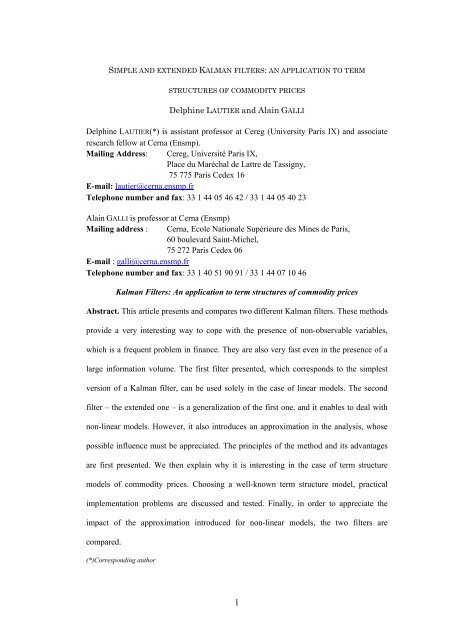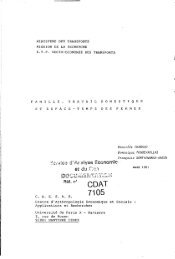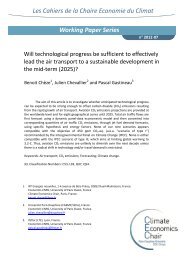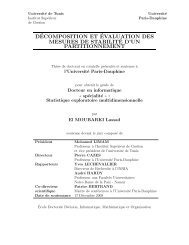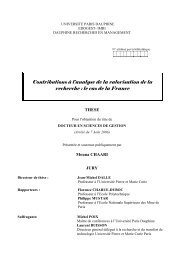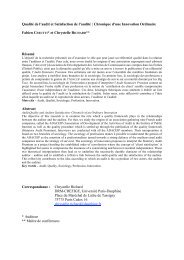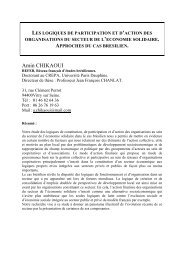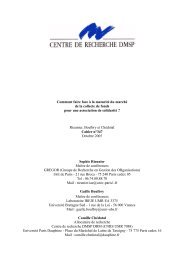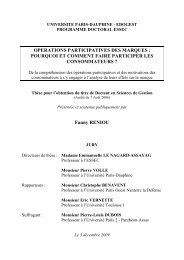Delphine LAUTIER and Alain GALLI Delphine LAUTIER(*) is ...
Delphine LAUTIER and Alain GALLI Delphine LAUTIER(*) is ...
Delphine LAUTIER and Alain GALLI Delphine LAUTIER(*) is ...
Create successful ePaper yourself
Turn your PDF publications into a flip-book with our unique Google optimized e-Paper software.
SIMPLE AND EXTENDED KALMAN FILTERS: AN APPLICATION TO TERM<br />
STRUCTURES OF COMMODITY PRICES<br />
<strong>Delphine</strong> <strong>LAUTIER</strong> <strong>and</strong> <strong>Alain</strong> <strong>GALLI</strong><br />
<strong>Delphine</strong> <strong>LAUTIER</strong>(*) <strong>is</strong> ass<strong>is</strong>tant professor at Cereg (University Par<strong>is</strong> IX) <strong>and</strong> associate<br />
research fellow at Cerna (Ensmp).<br />
Mailing Address: Cereg, Université Par<strong>is</strong> IX,<br />
Place du Maréchal de Lattre de Tassigny,<br />
75 775 Par<strong>is</strong> Cedex 16<br />
E-mail: lautier@cerna.ensmp.fr<br />
Telephone number <strong>and</strong> fax: 33 1 44 05 46 42 / 33 1 44 05 40 23<br />
<strong>Alain</strong> <strong>GALLI</strong> <strong>is</strong> professor at Cerna (Ensmp)<br />
Mailing address : Cerna, Ecole Nationale Supérieure des Mines de Par<strong>is</strong>,<br />
60 boulevard Saint-Michel,<br />
75 272 Par<strong>is</strong> Cedex 06<br />
E-mail : galli@cerna.ensmp.fr<br />
Telephone number <strong>and</strong> fax: 33 1 40 51 90 91 / 33 1 44 07 10 46<br />
Kalman Filters: An application to term structures of commodity prices<br />
Abstract. Th<strong>is</strong> article presents <strong>and</strong> compares two different Kalman filters. These methods<br />
provide a very interesting way to cope with the presence of non-observable variables,<br />
which <strong>is</strong> a frequent problem in finance. They are also very fast even in the presence of a<br />
large information volume. The first filter presented, which corresponds to the simplest<br />
version of a Kalman filter, can be used solely in the case of linear models. The second<br />
filter – the extended one – <strong>is</strong> a generalization of the first one, <strong>and</strong> it enables to deal with<br />
non-linear models. However, it also introduces an approximation in the analys<strong>is</strong>, whose<br />
possible influence must be appreciated. The principles of the method <strong>and</strong> its advantages<br />
are first presented. We then explain why it <strong>is</strong> interesting in the case of term structure<br />
models of commodity prices. Choosing a well-known term structure model, practical<br />
implementation problems are d<strong>is</strong>cussed <strong>and</strong> tested. Finally, in order to appreciate the<br />
impact of the approximation introduced for non-linear models, the two filters are<br />
compared.<br />
(*)Corresponding author<br />
1
SIMPLE AND EXTENDED KALMAN FILTERS:<br />
AN APPLICATION TO TERM STRUCTURES OF COMMODITY PRICES<br />
ABSTRACT: Th<strong>is</strong> article presents <strong>and</strong> compares two different Kalman filters. These<br />
methods provide a very interesting way to cope with the presence of non-observable<br />
variables, which <strong>is</strong> a frequent problem in finance. They are also very fast even for large<br />
data sets. The first filter presented, which corresponds to the simplest version of a<br />
Kalman filter, can be used solely for linear models. The second filter – the extended one –<br />
<strong>is</strong> a generalization of the first that can deal with non-linear models. However, it also<br />
introduces an approximation into the analys<strong>is</strong>, whose possible influence must be<br />
evaluated. The principles of the method <strong>and</strong> its advantages are first presented. We then<br />
explain why it <strong>is</strong> interesting in the case of term structure models of commodity prices.<br />
Choosing a well-known term structure model, practical implementation problems are<br />
d<strong>is</strong>cussed <strong>and</strong> tested. Finally, in order to appreciate the impact of the approximation<br />
introduced for non-linear models, the two filters are compared.<br />
I. THE KALMAN FILTERS: A BRIEF INTRODUCTION 1<br />
The main principle of the Kalman filters <strong>is</strong> to use temporal series of observable<br />
variables in order to reconstitute the values of non-observable variables. In finance, the<br />
problem of non-observable variables ar<strong>is</strong>es for example with term structure models of<br />
interest rates, term structure models of commodity prices <strong>and</strong> with market portfolios in<br />
the capital asset pricing model. When associated with an optimization procedure, the<br />
Kalman filter provides a way to estimate the model parameters. Finally <strong>and</strong> most<br />
importantly, because it <strong>is</strong> very fast, the method <strong>is</strong> also interesting for large data sets.<br />
2
There are different versions of Kalman filters 2 . The simple one <strong>is</strong> also the most<br />
famous <strong>and</strong> it <strong>is</strong> quite frequently used in finance nowadays 3 . Nevertheless, it <strong>is</strong> not<br />
suitable for nonlinear models. In that case, an extended filter can be used. However, the<br />
latter relies on an approximation, whose possible influence on the model performances<br />
needs to be assessed. Apart from th<strong>is</strong> d<strong>is</strong>tinction, the two filters rely on the same<br />
principles.<br />
The Kalman filter <strong>is</strong> an iterative process. The model has to be expressed in a<br />
state-space form characterized by a transition equation <strong>and</strong> a measurement equation 4 . Th<strong>is</strong><br />
transition equation describes the dynamics of the state variables α ~ , for which there are no<br />
empirical data. During the first step of the iteration – the prediction phase – th<strong>is</strong> equation<br />
<strong>is</strong> used to compute the values of the non-observable variables at time t, conditionally on<br />
the information available at time (t-1). The predicted values<br />
~ α t / t −1<br />
are then substituted<br />
into the measurement equation to determine the value of the measures<br />
~<br />
yt<br />
. The<br />
measurement equation represents the relationship linking the observable variables y ~ with<br />
the non-observable α ~ . In the second iteration step – or innovation phase – the innovation<br />
vt, which <strong>is</strong> the difference, at t, between the measure<br />
~<br />
yt<br />
<strong>and</strong> the empirical data yt <strong>is</strong><br />
calculated. The innovation <strong>is</strong> used, in the third iteration step – or updating phase – to<br />
obtain the value of α t<br />
~ conditionally on the information available at t. Once th<strong>is</strong><br />
calculation has been made, α t<br />
~ <strong>is</strong> used to begin a new iteration. Thus, the Kalman filter<br />
makes it possible to evaluate the non-observable variables α ~ , <strong>and</strong> it updates their value<br />
in each step using the new information.<br />
Th<strong>is</strong> brief presentation explains why the Kalman filter <strong>is</strong> a very fast method.<br />
Indeed, to reconstitute the temporal series of the non-observable variables, only two<br />
elements are necessary: the transition equation <strong>and</strong> the innovation v. Because there <strong>is</strong> an<br />
updating phase in the iteration, very little information <strong>is</strong> needed.<br />
3
The remainder of the paper <strong>is</strong> organized as follows. Section II presents the term<br />
structure models of commodity prices <strong>and</strong> explains why their use necessitates resorting to<br />
the Kalman filters. Section III explains how to apply the simple <strong>and</strong> the extended Kalman<br />
filters to a well-known model developed by Schwartz in 1997. Relying on the model<br />
performances, section IV compares the two filters <strong>and</strong> d<strong>is</strong>cusses some practical<br />
implementation problems. Section V concludes.<br />
II. THE TERM STRUCTURE MODELS OF COMMODITY PRICES<br />
In th<strong>is</strong> section, after describing some general features characterizing the term<br />
structure models of commodity prices, we present the model used for the compar<strong>is</strong>on<br />
between the simple <strong>and</strong> the extended Kalman filters: Schwartz’s model.<br />
General presentation<br />
The term structure of commodity futures prices describes the relationships<br />
between the spot price <strong>and</strong> futures prices for different delivery dates. So it synthesizes all<br />
the information available in the market. Several term structure models have been<br />
proposed in the literature. Their objective <strong>is</strong> firstly to reproduce the observed futures<br />
prices as accurately as possible, <strong>and</strong> secondly to extend the curve for very long maturities,<br />
even for delivery dates which are not available in the market.<br />
Term structure models borrow from the contingent claim analys<strong>is</strong> developed in a<br />
partial equilibrium framework for options <strong>and</strong> interest rates models. Relying on arbitrage<br />
reasoning, the development of a term structure model of commodity prices follows three<br />
successive steps: identification of the state variables, specification of their dynamics <strong>and</strong><br />
extraction of the futures prices values from a differential valuation equation.<br />
When only one state variable <strong>is</strong> used to explain the futures prices behaviour, as <strong>is</strong><br />
the case, for example, in Brennan <strong>and</strong> Schwartz’s model (1985), th<strong>is</strong> single factor <strong>is</strong> the<br />
spot price. Recognizing the limits of such a formulation, several models based upon two<br />
4
state variables have been proposed (Schwartz, 1997; Hilliard <strong>and</strong> Re<strong>is</strong>, 1998; Lautier,<br />
2000). In that case, the second factor <strong>is</strong> the convenience yield, which can be briefly<br />
defined as the comfort associated with the possession of physical stocks (Brennan, 1958).<br />
The introduction of a second state variable allows for richer shapes of curves <strong>and</strong><br />
volatility structures. Th<strong>is</strong> improvement <strong>is</strong> however costly because the models are<br />
naturally more complicated. The difficulty ar<strong>is</strong>es from the increasing number of<br />
parameters <strong>and</strong> from the non-observable nature of the state variables. In fact, there are<br />
usually no empirical data for these two variables because there <strong>is</strong> generally a lack of<br />
reliable time series for the spot price 5 , <strong>and</strong> convenience yield <strong>is</strong> not a traded asset.<br />
Therefore, there <strong>is</strong> a need for a method like the Kalman filter.<br />
Schwartz’s model<br />
Schwartz’s model (1997) <strong>is</strong> a well-known term structure model of commodity<br />
prices. Three reasons lead to choose it. Firstly, it performs well. Secondly, it has an<br />
analytical solution, which simplifies the application of the Kalman filters. Thirdly, it<br />
allows for the use of a simple Kalman filter, provided some precautions are taken.<br />
Schwartz’s model supposes that the spot price S <strong>and</strong> the convenience yield C can<br />
explain the behavior of the futures prices F. The dynamics of these state variables <strong>is</strong>:<br />
⎧dS<br />
= ( µ − C)<br />
Sdt + σ S Sdz<br />
⎨<br />
⎩dC<br />
= [ k(<br />
α − C)<br />
] dt + σ Cdz<br />
with: κ, σS, σC >0<br />
where: - µ <strong>is</strong> the drift of the spot price,<br />
- σ S <strong>is</strong> the volatility of the spot price,<br />
- dzS <strong>is</strong> an increment to a st<strong>and</strong>ard Brownian motion associated with S,<br />
- α <strong>is</strong> the long run mean of the convenience yield,<br />
- κ <strong>is</strong> the speed of adjustment of the convenience yield,<br />
- σ C <strong>is</strong> the convenience yield volatility,<br />
- dzC <strong>is</strong> an increment to a st<strong>and</strong>ard Brownian motion associated with C.<br />
5<br />
S<br />
C
As the storage theory showed, the two state variables are correlated because both<br />
the spot price <strong>and</strong> the convenience yield are an inverse function of the inventory levels.<br />
Nevertheless, as Gibson <strong>and</strong> Schwartz (1990) demonstrated, the correlation between these<br />
two variables <strong>is</strong> not perfect:<br />
[ dz × dz ] = ρdt<br />
E S C<br />
where ρ <strong>is</strong> the correlation between the two Brownian motions associated with S <strong>and</strong> C.<br />
The convenience yield <strong>is</strong> mean reverting <strong>and</strong> <strong>is</strong> involved in the spot price<br />
dynamics. Mean reversion relies on the hypothes<strong>is</strong> that there <strong>is</strong> a level of stocks which<br />
sat<strong>is</strong>fies the needs of industry under normal conditions. The behaviour of the operators in<br />
the physical market guarantees the ex<strong>is</strong>tence of th<strong>is</strong> normal level of stocks. When the<br />
convenience yield <strong>is</strong> low, the stocks are abundant <strong>and</strong> the operators sustain a high storage<br />
cost compared with the benefits related to holding the raw materials. So, if they are<br />
rational, they try to reduce these surplus stocks. Conversely, when the stocks are rare, the<br />
operators tend to reconstitute them.<br />
The solution of the term structure model can be expressed in a r<strong>is</strong>k neutral<br />
framework, using a Feynman-Kac solution. Therefore, the value of the futures prices can<br />
be written as:<br />
F<br />
Qλ ( t,<br />
T ) = E [ S(<br />
T ) ]<br />
where F(t,T) <strong>is</strong> the futures price at t for delivery at T, <strong>and</strong> Q λ denotes the r<strong>is</strong>k neutral<br />
probability 6 , which <strong>is</strong> dependent of an unknown value λ. The latter <strong>is</strong> the market price of<br />
convenience yield r<strong>is</strong>k. The solution <strong>is</strong>:<br />
with: B(<br />
τ )<br />
−<br />
⎡ 1−<br />
e<br />
F(<br />
S,<br />
C,<br />
t,<br />
T ) = S(<br />
t)<br />
× exp⎢−<br />
C(<br />
t)<br />
⎣ κ<br />
6<br />
κτ<br />
⎤<br />
+ B(<br />
τ )⎥<br />
⎦<br />
⎡<br />
2<br />
⎤ 2 −2κτ<br />
⎡<br />
2<br />
−<br />
⎛<br />
⎞ ⎡ − ⎤ ⎛<br />
⎞ ⎛ −<br />
⎢⎜<br />
) σC<br />
σSσC<br />
ρ σ<br />
⎟<br />
C 1 e<br />
× ⎥ + ⎢ × ⎥ + ⎢⎜<br />
) σC<br />
1 e<br />
=<br />
⎟×<br />
⎜<br />
⎜<br />
r −α<br />
+ −<br />
⎟<br />
τ<br />
⎜<br />
ακ<br />
+ σ σ ρ −<br />
2<br />
3<br />
S C ⎟ ⎜ 2<br />
⎢⎣<br />
⎝ 2κ κ ⎠ ⎥⎦<br />
⎣ 4 κ ⎦ ⎢⎣<br />
⎝<br />
κ ⎠ ⎝ κ<br />
)<br />
α = α − /<br />
( λ κ )<br />
κτ<br />
⎞⎤<br />
⎟<br />
⎥ ,<br />
⎠⎥⎦
where : - r <strong>is</strong> the r<strong>is</strong>k free interest rate, assumed constant,<br />
- τ = T - t <strong>is</strong> the maturity of the futures contract.<br />
To assess the model’s performances, we first need the optimal values of the<br />
parameters, which can then be used to compute the estimated futures prices <strong>and</strong> to<br />
compare them with empirical data.<br />
III. APPLYING THE KALMAN FILTERS<br />
In th<strong>is</strong> section, the way to transform Schwartz’s model into a state-space model <strong>is</strong><br />
explained, for the simple <strong>and</strong> for the extended filters. Then, implementation problems are<br />
d<strong>is</strong>cussed.<br />
Simple filter<br />
The simple filter <strong>is</strong> suited for linear models. To apply it, the solution of<br />
Schwartz’s model must be expressed on a linear form:<br />
ln<br />
Letting G = ln(S), we also have 7 :<br />
( F ( S,<br />
C,<br />
t,<br />
T ) ) = ln(<br />
S(<br />
t)<br />
) − C(<br />
t)<br />
× + B(<br />
τ )<br />
7<br />
1−<br />
e<br />
κ<br />
⎧<br />
1 2<br />
⎪dG<br />
= ( µ − C − σ S ) dt + σ Sdz<br />
⎨<br />
2<br />
⎪<br />
⎩dC<br />
= [ k(<br />
α − C)<br />
] dt + σ CdzC<br />
The state-space form of the model <strong>is</strong> the following. The transition equation <strong>is</strong> the<br />
expression, in d<strong>is</strong>crete time, of the state variables dynamics. Using the same notation as<br />
before, th<strong>is</strong> equation <strong>is</strong>:<br />
where:<br />
~<br />
⎡G<br />
⎢ ~<br />
⎢⎣<br />
C<br />
⎤<br />
c<br />
T<br />
~<br />
⎡G<br />
t / t −1<br />
t −1<br />
⎥ = + × ⎢ ~ ⎥ + R<br />
t / t −1⎥<br />
⎢Ct<br />
−1⎥<br />
- N <strong>is</strong> the number of maturities used for the estimation,<br />
⎦<br />
⎣<br />
⎤<br />
⎦<br />
t<br />
−κτ<br />
η , t = 1, ... NT<br />
S
-<br />
⎡⎛<br />
1 2 ⎞ ⎤<br />
⎢⎜<br />
µ − σ S ⎟∆t<br />
c =<br />
⎥<br />
⎢⎝<br />
2 ⎠ ⎥<br />
⎣ κα∆t<br />
⎦<br />
- ∆t <strong>is</strong> the period separating 2 observation dates,<br />
⎡1<br />
− ∆t<br />
⎤<br />
- T = ⎢ ⎥<br />
⎣0<br />
1−<br />
κ∆t⎦<br />
- R <strong>is</strong> the identity matrix, (2 × 2),<br />
- ηt are errors that are uncorrelated with the previous values of the state variables, <strong>and</strong><br />
have no serial correlation :<br />
2 ⎡ σ<br />
⎤<br />
S∆t<br />
ρσ Sσ<br />
C∆t<br />
E[ηt] = 0, <strong>and</strong> Q = Var[<br />
η t ] = ⎢<br />
2 ⎥<br />
⎣ρσ<br />
Sσ<br />
C∆t<br />
σ C∆t<br />
⎦<br />
The measurement equation comes directly from the model pricing formula, which<br />
must also be d<strong>is</strong>cretized:<br />
where :<br />
~<br />
~ ⎡G<br />
⎤ t / t −1<br />
yt / t −1<br />
= d + Z × ⎢ ~ ⎥ + εt<br />
, t = 1, ... NT<br />
⎢⎣<br />
Ct<br />
/ t −1⎥⎦<br />
- the i th line of the N dimensional vector of the observable variables ~<br />
t / t−1<br />
with i = 1,..,N,<br />
- d = [B(τi)] <strong>is</strong> the i th line of the d vector, with i = 1,..., N, <strong>and</strong> where:<br />
⎡<br />
2<br />
⎤ 2 −<br />
⎛ ) σ ⎞ ⎡ −<br />
⎢⎜<br />
C σSσ<br />
Cρ<br />
σ<br />
⎟<br />
C 1 e<br />
B(<br />
τi)<br />
=<br />
⎜<br />
r −α<br />
+ −<br />
⎟<br />
× τ ⎥ + ⎢ ×<br />
2<br />
i<br />
3<br />
⎢⎣<br />
⎝ 2κ<br />
κ ⎠ ⎥⎦<br />
⎣ 4 κ<br />
)<br />
α = α − λ / κ<br />
- Z = [ , − H ]<br />
where:<br />
i<br />
8<br />
~ ( )<br />
y <strong>is</strong> F( τ )<br />
ln ,<br />
⎡<br />
2<br />
−<br />
⎤ ⎛ ) σ ⎞ ⎛ −<br />
⎢⎜<br />
C 1<br />
⎥ +<br />
⎟×<br />
⎜<br />
⎜<br />
ακ<br />
+ σSσ<br />
Cρ<br />
−<br />
⎟ ⎜ 2<br />
⎦ ⎢⎣<br />
⎝<br />
κ ⎠ ⎝ κ<br />
2κτi<br />
κτi<br />
e<br />
1 <strong>is</strong> the i th line of the Z matrix, which <strong>is</strong> (N×2), with i = 1,...,N <strong>and</strong><br />
H i<br />
−<br />
− e<br />
=<br />
κ<br />
1<br />
κτ i<br />
- εt <strong>is</strong> a white no<strong>is</strong>e vector, (N×1), with no serial correlation:<br />
E[εt] = 0 <strong>and</strong> H = Var[εt]. (N × N)<br />
i<br />
⎞⎤<br />
⎟<br />
⎥<br />
⎠⎥⎦
In continuous time, the pricing equation of a term structure model does not<br />
involve any error term ε. The use of a Kalman filter leads to the introduction of th<strong>is</strong> term,<br />
which <strong>is</strong> difficult to estimate. Th<strong>is</strong> term can be interpreted as follows. Firstly, it st<strong>and</strong>s for<br />
market imperfections <strong>and</strong> arbitrage opportunities. Secondly, as the Kalman filter <strong>is</strong> a kind<br />
of inverse process, which <strong>is</strong> often unstable, it can be considered as a regularization term.<br />
Its addition leads to a d<strong>is</strong>tribution for y% , which <strong>is</strong> the initial one, convoluted with a<br />
Gaussian kernel.<br />
Extended filter<br />
In an extended filter, the previous system matrices Z, T <strong>and</strong> R are replaced with<br />
non-linear functions depending on the state variables. So there <strong>is</strong> no need to linearize<br />
Schwartz’s model. The transition equation becomes:<br />
where:<br />
~<br />
⎡S<br />
⎢ ~<br />
⎢⎣<br />
C<br />
~ ~<br />
~ ~ ⎡St<br />
−1<br />
- ( ) ( 1+<br />
µ ∆t<br />
− Ct<br />
−1∆t)<br />
T S , C =<br />
t −1<br />
t −1<br />
~<br />
~ ~ ⎡S<br />
1<br />
t −<br />
- R ( St<br />
−1,<br />
Ct<br />
−1)<br />
= ⎢ ⎥<br />
0 1⎦<br />
⎤<br />
~<br />
~<br />
t / t−<br />
1<br />
⎥ = T ( St<br />
−1,<br />
Ct<br />
−1)<br />
+ R(<br />
St<br />
−1,<br />
Ct<br />
−1<br />
t / t−1<br />
⎥<br />
( )⎥ ⎥ ⎤<br />
⎢ ~<br />
⎢⎣<br />
κα∆t + Ct<br />
−1<br />
1−<br />
κ∆t<br />
⎦<br />
⎣<br />
⎡<br />
=<br />
2<br />
σ<br />
0⎤<br />
S<br />
S C<br />
- Q Var(<br />
η t ) ⎢<br />
⎥<br />
⎣ρσ<br />
Sσ<br />
C σ C ⎦<br />
⎦<br />
ρσ σ ⎤<br />
= 2<br />
The measurement equation becomes:<br />
~ ~<br />
where: ( S , C )<br />
t / t −1 t / t −1<br />
9<br />
~<br />
~ ~ ( St<br />
/ t −1,<br />
Ct<br />
/ t ) + t<br />
~<br />
y ε<br />
t / t −1 = Z<br />
−1<br />
Z <strong>is</strong> an N dimensional vector, whose i th line <strong>is</strong> (i = 1,..., N):<br />
~<br />
~<br />
[ St / t−<br />
1 × exp(<br />
− H i Ct<br />
/ t−1<br />
+ B(<br />
τ i ) ) ]<br />
~<br />
) η<br />
t
In the extended filter, as the transition <strong>and</strong> measurement equations are non-linear,<br />
there <strong>is</strong> no analytical formula for the conditional expectations. Therefore, the latter must<br />
be approximated. Th<strong>is</strong> approximation does not appear in the simple filter.<br />
Implementation problems<br />
Some difficulties must be overcome when using Kalman filters. First, some<br />
choices must be made to start the iterative process. Second, if the model has been<br />
expressed as the logarithm for the simple Kalman filter, some precautions must be taken.<br />
Third, the covariance matrix H influences the performances.<br />
Starting the iterative process<br />
To start the iterative process, initial values of the non-observable variables <strong>and</strong> of<br />
their covariance matrix are needed.<br />
For the term structure models of commodity prices, the non-observable state<br />
variables are usually the spot price <strong>and</strong> the convenience yield. The nearest futures price <strong>is</strong><br />
generally used as the spot price S, <strong>and</strong> the convenience yield C can be computed from the<br />
solution of Brennan <strong>and</strong> Schwartz’s model (1985). Th<strong>is</strong> solution requires the use of two<br />
observed futures prices, for delivery at T1 <strong>and</strong> at T2:<br />
ln<br />
C ( t ) = r −<br />
( F ( S , t,<br />
T ) ) − ln ( F ( S , t,<br />
T ) )<br />
10<br />
1<br />
T − T<br />
where T1 <strong>is</strong> the nearest delivery, <strong>and</strong> T2 <strong>is</strong> the next one.<br />
1<br />
The covariance matrix associated with the state variables must also be initialized.<br />
We choose a diagonal matrix with the spot price <strong>and</strong> the convenience yield variances on<br />
the diagonal. These variances were computed from the 30 first dates in the estimation<br />
period.<br />
Analyzing the results of the simple filter<br />
When the model <strong>is</strong> expressed in its logarithmic form in the case of the simple filter,<br />
some precautions must be taken to measure the model’s performances, because the<br />
innovations are computed with logarithms. A difficulty ar<strong>is</strong>es when the estimated <strong>and</strong><br />
2<br />
2
empirical data are rebuilt. The relationship linking the estimations logarithm ~ y t / t −1<br />
with<br />
the observations logarithm yt <strong>is</strong> the following:<br />
y ~<br />
t y t / t<br />
= −1<br />
11<br />
+ σR<br />
where σ <strong>is</strong> the st<strong>and</strong>ard error of the innovations <strong>and</strong> R <strong>is</strong> a gaussian residue. To be more<br />
prec<strong>is</strong>e, when the estimated logarithm <strong>is</strong> used to obtain the estimates themselves, the<br />
relationship between yt <strong>and</strong> t / t 1<br />
The expectation <strong>is</strong> then 8 :<br />
~ y − becomes :<br />
E<br />
e<br />
y<br />
t<br />
= e<br />
~ y<br />
t / t−1<br />
× e<br />
σR<br />
2<br />
σ<br />
y<br />
~<br />
t yt<br />
/ t−<br />
1 2<br />
[ e ] = E[<br />
e ] × e<br />
Therefore, a corrective term should be added to the estimations exponential. From<br />
a theoretical point of view, th<strong>is</strong> <strong>is</strong> quite difficult, because the innovations variance <strong>is</strong><br />
modified as soon as the parameters change. We nevertheless performed empirical tests, in<br />
order to measure th<strong>is</strong> bias.<br />
Measuring the performances<br />
Another important choice must be made before initiating the iteration process,<br />
concerning the error covariance matrix H. Th<strong>is</strong> matrix <strong>is</strong> important because it <strong>is</strong> added to<br />
the innovations covariance matrix during the innovation phase. In the simple Kalman<br />
filter, the relationship between the innovations matrix Ft <strong>and</strong> the system matrix H <strong>is</strong>:<br />
Ft t / t 1<br />
= ZP − Z'+<br />
H<br />
where Pt/t-1 <strong>is</strong> the covariance matrix of the non-observable variables <strong>and</strong> Z <strong>is</strong> a system<br />
matrix included in the measurement equation.<br />
During the next iteration phase, the inverse of the innovations matrix <strong>is</strong> used to<br />
update the non-observable variables <strong>and</strong> their covariance matrix:<br />
⎪⎧<br />
~ α<br />
= ~<br />
t αt<br />
/<br />
⎨<br />
⎪⎩ Pt<br />
=<br />
t −1<br />
+ P<br />
−1<br />
( I − P Zˆ<br />
'F<br />
Zˆ<br />
)<br />
t / t −1<br />
t / t −1<br />
t<br />
Zˆ<br />
F<br />
t<br />
'<br />
t<br />
−1<br />
t vt<br />
t<br />
P<br />
t / t −1
So, the matrix H has an influence on the updated values of the non-observable<br />
variables. If its terms are too high, the model performances will be poor. Most of the<br />
time, th<strong>is</strong> matrix <strong>is</strong> estimated relying on the variances <strong>and</strong> the covariance of the<br />
estimations database. We used th<strong>is</strong> method in th<strong>is</strong> article <strong>and</strong> we show how strongly th<strong>is</strong><br />
choice affects the empirical results.<br />
IV. COMPARISON BETWEEN THE TWO FILTERS<br />
Comparing the performances of Schwartz’s model measured with the two filters<br />
makes it possible to assess the influence of the linearization on the results. In th<strong>is</strong> section,<br />
the empirical data are first presented. Then the performance criteria are presented.<br />
Finally, the results are delivered <strong>and</strong> commented.<br />
Data<br />
The data used for the empirical study are daily crude oil settlement prices for the<br />
West Texas Intermediate (WTI) futures contracts negotiated on the New York Mercantile<br />
Exchange (Nymex) from 09/25/1995 to 01/14/2002. They have been arranged so that the<br />
first futures price maturity τ1 <strong>is</strong> the one month maturity, <strong>and</strong> that the second futures price<br />
corresponds to the two months maturity τ2, ... Keeping the first observation of each group<br />
of five, th<strong>is</strong> daily data were transformed into weekly data. Four series of futures prices 9<br />
corresponding to maturities of one, three, six <strong>and</strong> nine were used to estimate the<br />
parameters, <strong>and</strong> to measure the model’s performance.<br />
The interest rates are T-bill rates for a three months maturity. As they are<br />
supposed to be constant in the model, we used the mean of all the observations between<br />
1995 <strong>and</strong> 2002.<br />
Performances criteria<br />
Two criteria were used to measure the model performances: the mean pricing<br />
error (MPE) <strong>and</strong> the root mean squared errors (RMSE).<br />
12
The MPE <strong>is</strong> defined as follows:<br />
1<br />
MPE =<br />
N<br />
N<br />
∑<br />
n=<br />
1<br />
where N <strong>is</strong> the number of observations, ( , τ )<br />
τ at the date n, <strong>and</strong> ( n,<br />
τ )<br />
~ ( F(<br />
n,<br />
τ ) − F(<br />
n,<br />
τ ) )<br />
~<br />
F n <strong>is</strong> the estimated futures price for maturity<br />
F <strong>is</strong> the observed futures price. The MPE <strong>is</strong> expressed in US<br />
dollars. It measures the estimation bias for one given maturity. If the estimation <strong>is</strong> good,<br />
the MPE should be very close to zero.<br />
maturity τ:<br />
Using the same notation, the RMSE, expressed in US dollars, <strong>is</strong>, for a given<br />
RMSE =<br />
1<br />
N<br />
N<br />
∑<br />
n=<br />
1<br />
~ ( F(<br />
n,<br />
τ ) − F(<br />
n,<br />
τ ) )<br />
When there <strong>is</strong> no bias, the RMSE can be considered as an empirical variance. It measures<br />
the estimation stability. Th<strong>is</strong> second criterion <strong>is</strong> considered as more representative<br />
because price errors can offset themselves <strong>and</strong> the MPE can be low even if there are<br />
strong deviations.<br />
Empirical results<br />
The estimation periods used to obtain the parameters are for the following<br />
periods: 09/25/95-05/11/98 <strong>and</strong> 05/18/98-10/15/01. After comparing the optimal<br />
parameters obtained with the two filters, we measure the model’s ability to represent the<br />
prices curves on the learning database <strong>and</strong> on an exp<strong>and</strong>ed one. Finally, the sensitivity of<br />
the results to the error covariance matrix are examined.<br />
Optimal parameters<br />
The optimal parameters were estimated with the simple <strong>and</strong> the extended filters 10 .<br />
The results obtained for the two periods are represented in Tables 1 <strong>and</strong> 2. They lead to<br />
two remarks. Firstly, the parameters values change with the estimation period. Th<strong>is</strong> was<br />
observed in several earlier studies. Considering that the parameters are constant <strong>is</strong> rather<br />
13<br />
2
estrictive but it significantly reduces the complexity of the analys<strong>is</strong>. Secondly, the<br />
optimal parameters obtained with the two filters are different. During the first period, the<br />
optimal parameters obtained with the extended filter are usually higher than those<br />
associated with the simple filter. The principal differences concern the r<strong>is</strong>k premium λ<br />
<strong>and</strong> the long run mean α . For the second period, the differences are lower, <strong>and</strong> the most<br />
important ones concern the volatilities of the state variables.<br />
These differences show that the linearization has had a significant influence on<br />
the parameters. Nevertheless, the latter have always the same order size that those<br />
obtained by Schwartz in 1997 on the crude oil market <strong>and</strong> on different periods.<br />
The model performances<br />
A simple graphical analys<strong>is</strong> <strong>is</strong> first used to comment the model performances<br />
obtained with the two filters. Then the MPE <strong>and</strong> RMSE criteria are used to compare<br />
them. The results associated with the simple filter are also corrected for the logarithm.<br />
Lastly the innovations obtained with the two filters are compared.<br />
Figure 1 represents the one-month futures prices observed during 1998-2001 <strong>and</strong><br />
compares them with the futures prices estimated with the two filters. Th<strong>is</strong> graphic shows<br />
that firstly, the two filters, especially the simple one, attenuate the range of price<br />
fluctuations. We observed th<strong>is</strong> phenomenon for the two study periods <strong>and</strong> for every<br />
maturity. Secondly, the Kalman filters can be used with extremely volatile data. During<br />
1998-2001, the crude oil prices ranged from USD 11 per barrel to USD 37!<br />
Tables 3 <strong>and</strong> 4 give the performances of Schwartz’s model, measured by the<br />
MPE <strong>and</strong> the RMSE criteria. Three conclusions can be drawn from these results. Firstly,<br />
the model <strong>is</strong> able to reproduce the prices curve quite prec<strong>is</strong>ely. The average MPE <strong>is</strong><br />
always less than 18 cents per barrel <strong>and</strong> the RMSE <strong>is</strong> quite low, especially for the shorter<br />
period (1995-1998). Secondly, if the RMSE <strong>is</strong> the relevant criterion, then the simple filter<br />
<strong>is</strong> always more prec<strong>is</strong>e than the extended one. Thirdly, these measures always decrease<br />
14
with maturity, which <strong>is</strong> cons<strong>is</strong>tent with Schwartz’s results on others periods.<br />
Nevertheless, Schwartz worked with longer maturities, <strong>and</strong> showed that the root mean<br />
squared error increases again for deliveries after 15 months.<br />
To be rigorous, the model performances associated with the simple Kalman filter<br />
should be corrected when the model in expressed in terms of logarithms. Table 5<br />
compares the performances obtained with <strong>and</strong> without correction. The results show that<br />
the correction slightly improves the performances. Therefore, in our case, the bias<br />
associated with the logarithm as a minor influence on the results, probably because the<br />
variance of the residuals <strong>is</strong> small for reasonable parameters values.<br />
Finally, Figure 2 represents the behavior of the innovations for the one-month<br />
maturity <strong>and</strong> for the second study period. It shows that for both filters, the innovations<br />
tend to return to zero. The same observation can be made for the others maturities,<br />
likew<strong>is</strong>e for both periods. The figure also shows that even if the MPE are low for the two<br />
filters, the pricing errors can be rather important at certain dates.<br />
The performances analys<strong>is</strong> shows that there <strong>is</strong> clearly an impact of the<br />
linearization introduced in the extended filter. However, the most important <strong>is</strong> that, even<br />
if th<strong>is</strong> impact <strong>is</strong> negative, the model’s ability to represent the prices curve <strong>is</strong> still good<br />
with an extended filter.<br />
Exp<strong>and</strong>ing the database<br />
The parameter estimates vary with the estimation periods. Hence, one question<br />
ar<strong>is</strong>es: how often <strong>is</strong> it necessary to recalculate the parameters? In order to answer that<br />
question, we used the parameters previously estimated to measure the model<br />
performances on an exp<strong>and</strong>ed database. We carried out these tests on two intervals of<br />
three months located in the prolongation of the estimation periods, namely 05/18/98 -<br />
08/17/98 <strong>and</strong> 10/21/01 - 01/14/02. Tables 6 <strong>and</strong> 7 present our results. Two conclusions<br />
can be drawn.<br />
15
Firstly, in 1998, the model <strong>is</strong> more prec<strong>is</strong>e with the extended filter. However, in<br />
2001-2002, the simple filter gives again the best performances. Secondly, the model<br />
performances decrease strongly when the database <strong>is</strong> exp<strong>and</strong>ed. The RMSE <strong>and</strong> the MPE<br />
r<strong>is</strong>e dramatically for the two periods. Th<strong>is</strong> phenomenon <strong>is</strong> particularly pronounced when<br />
the futures prices are volatile, during 2001-2002, <strong>and</strong> it will probably be even more<br />
marked as the database <strong>is</strong> increased. So, there <strong>is</strong> a strong incentive to recalculate the<br />
optimal parameters each time the model <strong>is</strong> used. Th<strong>is</strong> <strong>is</strong> not a major drawback, at least<br />
when there <strong>is</strong> an analytical solution for the model, because the estimation process <strong>is</strong> very<br />
fast.<br />
Simulations<br />
The last results presented are simulations showing how the choice of the system<br />
matrix H, which represents the errors in the measurement equation, affects the model<br />
performances. The first results presented in Table 8 (observations) are obtained with a<br />
matrix whose components are the variances <strong>and</strong> the covariance of the observations. Th<strong>is</strong><br />
method <strong>is</strong> the most frequently used. The other performances (simulations) are carried out<br />
with artificially lowered matrices: in simulations 1 to 4, H was multiplied by (1/2), (1/16),<br />
(1/160), <strong>and</strong> (1/1600). For these tests, we retained the period 1998-2001 because it <strong>is</strong><br />
characterized by especially volatile data.<br />
Table 8 illustrates that, when the matrix components are lowered, the model<br />
performances improve strongly: from the initial performances to the fourth simulation,<br />
the RMSE <strong>is</strong> almost divided by two. However, comparing the third <strong>and</strong> the fourth<br />
simulation also shows that there <strong>is</strong> a limit to the improvement. Figure 3 summarizes the<br />
main results of these simulations.<br />
V. CONCLUSION<br />
16
Kalman filters are powerful tools suitable for use in many fields in finance,<br />
because they are fast even for large data sets <strong>and</strong> they can h<strong>and</strong>le unobservable variables.<br />
Moreover, they can be used for linear as well as non-linear models, even if the models<br />
have no analytical solutions.<br />
The main conclusions of th<strong>is</strong> article are the following. Firstly, the approximation<br />
introduced in the extended Kalman filter due to linearizing the model, clearly influences<br />
the model performances: the extended filter generally leads to less prec<strong>is</strong>e estimates than<br />
the simple one. Nevertheless, as the difference between the two filters <strong>is</strong> quite small, the<br />
extended filter <strong>is</strong> still acceptable in our case. So, the approximation <strong>is</strong> not a real problem<br />
until the model becomes highly nonlinear. Secondly, the system matrix containing the<br />
errors of the measurement equation affects the model performances <strong>and</strong> can be used to<br />
obtain more prec<strong>is</strong>e results. Thirdly, as far as the term structure models of commodity<br />
prices are concerned, the parameters are not constant in time <strong>and</strong> should be recomputed<br />
regularly. Th<strong>is</strong> can become a problem if the model has no analytical solution, because of<br />
the computing time.<br />
In order to improve the use of the Kalman filters, some further studies could be<br />
considered. For example, in the matrix representing the errors in the measurement<br />
equation (which <strong>is</strong> most of the time estimated with variances <strong>and</strong> covariance), we could<br />
also try to use variograms. Th<strong>is</strong> tool borrowed from geostat<strong>is</strong>tics are used to describe<br />
spatial or temporal correlation 11 . More prec<strong>is</strong>ely, a variogram models the variation of the<br />
correlations between a pair of points of the same variable as a function of the spatial or<br />
temporal d<strong>is</strong>tance. Another improvement could be done concerning the analys<strong>is</strong> of the<br />
bias associated with the logarithms in the simple Kalman filter. To reduce th<strong>is</strong> bias,<br />
variance minimization could be included in the iterative process used to estimate the<br />
optimal parameters. Lastly, to face the problem of time varying parameters in term<br />
structure models of commodity prices, one could study the sensitivity of the estimated<br />
futures prices to the parameters.<br />
17
ACKNOWLEDGMENTS<br />
We wh<strong>is</strong>h to thank the French Institute of Energy (Institut França<strong>is</strong> de l’Energie) for its<br />
support, <strong>and</strong> TotalFinaElf, who provided us with the empirical data used in th<strong>is</strong> study.<br />
REFERENCES<br />
Anderson, B.D.O. <strong>and</strong> Moore, J.B. (1979) Optimal filtering, Englewood Cliffs, Prentice<br />
Hall.<br />
Babbs, S.H. <strong>and</strong> Nowman, B.K. (1999) Kalman filtering of generalized Vasicek term<br />
structure models, Journal of Financial <strong>and</strong> Quantitative Analys<strong>is</strong>, 34, 115--130.<br />
Brennan, M.J. (1958) The supply of storage, American Economic Review, 47, 50--72.<br />
Brennan, M.J. <strong>and</strong> Schwartz, E.S. (1985) Evaluating natural resource investments,<br />
Journal of Business, 58, 135--157.<br />
Fouque, J.P, Papanicolaou, G. <strong>and</strong> Sircar, K. (2000) Derivatives in financial markets with<br />
stochastic volatility, Cambridge University Press.<br />
Gibson, R. <strong>and</strong> Schwartz, E.S. (1990) Stochastic convenience yield <strong>and</strong> the pricing of oil<br />
contingent claims, Journal of Finance, 45, 959--975.<br />
Harvey, A.C., (1989) Forecasting, structural time series models <strong>and</strong> the Kalman filter,<br />
Cambridge University Press.<br />
Hilliard, J.E. <strong>and</strong> Re<strong>is</strong>, J. (1998) Valuation of commodity futures <strong>and</strong> options under<br />
stochastic convenience yield, interest rates, <strong>and</strong> jump diffusions in the spot, Journal of<br />
Financial <strong>and</strong> Quantitative Analys<strong>is</strong>, 33, 61--86.<br />
Horsnell, P <strong>and</strong> Mabro, R. (1993) Oil markets <strong>and</strong> prices, Oxford University Press.<br />
Javaheri, A., Lautier, D. <strong>and</strong> Galli, A. (2003) Filtering in finance, Willmott magazine, 5,<br />
(forthcoming).<br />
Lautier, D. <strong>and</strong> Galli, A. (2002) Report on term structure models of commodity prices:<br />
elaboration <strong>and</strong> improvement, French Institute of Energy Research.<br />
18
Lautier, D. (2000) La structure par terme des prix des commodités: analyse théorique et<br />
applications au marché pétrolier, Ph. D thes<strong>is</strong>, University Par<strong>is</strong> IX.<br />
Schwartz, E.S. (1997) The stochastic behavior of commodity prices: implications for<br />
valuation <strong>and</strong> hedging, Journal of Finance, 52, 923--973.<br />
19
($/b)<br />
35<br />
30<br />
25<br />
20<br />
15<br />
10<br />
Figure 1. Estimated <strong>and</strong> observed futures prices for the one-month’s maturity, 1998-2001<br />
18/05/98<br />
18/07/98<br />
18/09/98<br />
18/11/98<br />
18/01/99<br />
18/03/99<br />
18/05/99<br />
18/07/99<br />
18/09/99<br />
18/11/99<br />
18/01/00<br />
18/03/00<br />
18/05/00<br />
18/07/00<br />
18/09/00<br />
18/11/00<br />
18/01/01<br />
18/03/01<br />
18/05/01<br />
18/07/01<br />
18/09/01<br />
Futures one month Simple filter Extended filter<br />
20
($/b)<br />
7<br />
6<br />
5<br />
4<br />
3<br />
2<br />
1<br />
0<br />
-1<br />
-2<br />
-3<br />
-4<br />
-5<br />
-6<br />
-7<br />
Figure 2. Innovations, 1998-2001<br />
18/05/98<br />
18/07/98<br />
18/09/98<br />
18/11/98<br />
18/01/99<br />
18/03/99<br />
18/05/99<br />
18/07/99<br />
18/09/99<br />
18/11/99<br />
18/01/00<br />
18/03/00<br />
18/05/00<br />
18/07/00<br />
18/09/00<br />
18/11/00<br />
18/01/01<br />
18/03/01<br />
18/05/01<br />
18/07/01<br />
18/09/01<br />
Simple filter Extended filter<br />
21
($/b)<br />
35,00<br />
30,00<br />
25,00<br />
20,00<br />
15,00<br />
10,00<br />
18/05/98<br />
18/07/98<br />
18/09/98<br />
Figure 3. One-month’s futures prices observed <strong>and</strong> estimated, 1998 - 2001<br />
18/11/98<br />
18/01/99<br />
18/03/99<br />
18/05/99<br />
18/07/99<br />
18/09/99<br />
18/11/99<br />
22<br />
18/01/00<br />
Observed futures prices for a one month's maturity<br />
Estimated futures prices for a one month's maturity with a matrix H corresponding to the observations.<br />
Estimated futures prices for a one month maturity <strong>and</strong> an artificially lowered matrix (Simulation 4)<br />
18/03/00<br />
18/05/00<br />
18/07/00<br />
18/09/00<br />
18/11/00<br />
18/01/01<br />
18/03/01<br />
18/05/01<br />
18/07/01<br />
18/09/01
Table 1. Optimal parameters, 1995-1998<br />
Simple filter Extended filter<br />
Parameters Gradients Parameters Gradients<br />
Drift : µ 0.142741 0.001629 0.192335 0.000083<br />
Speed of adjustment : κ 1.969842 -0.000265 2.023929 0.000114<br />
Spot price volatility : σS 0.241347 0.000177 0.228553 0.000339<br />
Long run mean : α 0.098906 0.001271 0.149024 0.001422<br />
Convenience yield volatility : σC 0.400676 -0.001242 0.383852 0.000053<br />
Correlation coefficient : ρ 0.967136 -0.000031 0.973072 -0.000001<br />
R<strong>is</strong>k premium : λ 0.088951 -0.001609 0.185988 -0.000883<br />
23
Table 2. Optimal parameters, 1998-2001<br />
Simple filter Extended filter<br />
Parameters Gradients Parameters Gradients<br />
Drift : µ 0.379926 0.000497 0.352014 -0.001178<br />
Speed of adjustment : κ 1.59171 -0.003631 1.258133 0.000628<br />
Spot price volatility : σS 0.263525 -0.000448 0.320235 -0.000338<br />
Long run mean : α 0.252260 -0.012867 0.232547 0.004723<br />
Convenience yield volatility : σC 0.237071 -0.000602 0.288427 -0.001070<br />
Correlation coefficient : ρ 0.938487 -0.001533 0.969985 0.000008<br />
R<strong>is</strong>k premium : λ 0.177159 0.009272 0.181955 -0.002426<br />
24
Table 3. The model’s performances with the simple <strong>and</strong> the extended filters, 1995-<br />
1998<br />
Simple filter Extended filter<br />
Maturity MPE RMSE MPE RMSE<br />
1 month -0.063 1.2769 0.0775 1.3972<br />
3 months 0.1064 1.1804 0.2145 1.3011<br />
6 months 0.1453 1.0142 0.2235 1.0861<br />
9 months 0.1419 0.8468 0.2029 0.8812<br />
Average 0.0827 1.0796 0.1796 1.1664<br />
Unit: USD/b.<br />
25
Table 4. The model’s performances with the simple <strong>and</strong> the extended filters, 1998-<br />
2001<br />
Simple filter Extended filter<br />
Maturity MPE RMSE MPE RMSE<br />
1 month -0.060423 2.319730 0.09793 2.294503<br />
3 months -0.107783 1.989428 0.057327 2.120727<br />
6 months -0.054536 1.715223 0.109584 1.877654<br />
9 months -0.007316 1.567467 0.141204 1.695222<br />
Average -0.057514 1.897962 0.101511 1.997027<br />
Unit: USD/b.<br />
26
Table 5. The simple filter with <strong>and</strong> without corrections for the logarithm, 1998-2001<br />
Simple filter Simple filter corrected<br />
Maturity MPE RMSE MPE RMSE<br />
1 month -0.060423 2.319730 0.065644 2.314178<br />
3 months -0.107783 1.989428 0.006419 1.981453<br />
6 months -0.054536 1.715223 0.026010 1.709931<br />
9 months -0.007316 1.567467 0.061301 1.564854<br />
Average -0.057514 1.897962 0.036637 1.892604<br />
Unit: USD/b.<br />
27
Table 6. The performances with a 3 months’ extrapolation, 1998<br />
Simple filter Extended filter<br />
Maturity MPE RMSE MPE RMSE<br />
1 month 2.0138 2.2012 1.7392 1.8834<br />
3 months 1.3296 1.3749 1.2448 1.3084<br />
6 months 0.6512 0.755 0.7563 0.8691<br />
9 months 0.2710 0.5442 0.4883 0.6540<br />
Average 1.0664 1.2188 1.0572 1.1787<br />
Unit: USD/b.<br />
28
Table 7. The performances with a 3 months’ extrapolation, 2001-2002<br />
Simple filter Extended filter<br />
Maturity MPE RMSE MPE RMSE<br />
1 month -0.710678 3.371702 -3.243584 3.837790<br />
3 months -0.379108 2.972144 -2.920091 3.408698<br />
6 months 0.155104 2.500216 -2.247877 2.649836<br />
9 months 0.385290 2.164323 -1.767425 2.123121<br />
Average -0.137348 2.750296 -2.544744 3.004861<br />
Unit: USD/b.<br />
29
Observations<br />
MPE<br />
RMSE<br />
Simulation 1<br />
MPE<br />
RMSE<br />
Simulation 2<br />
MPE<br />
RMSE<br />
Simulation 3<br />
MPE<br />
RMSE<br />
Simulation 4<br />
MPE<br />
RMSE<br />
Table 8. Simulations with different system matrices<br />
Unit: USD/b.<br />
1 month 3 months 6 months 9 months Average<br />
0.0979<br />
2.2945<br />
0.0013<br />
1.8356<br />
0.0073<br />
1.4759<br />
0.0035<br />
1.3812<br />
0.0131<br />
1.3602<br />
0.0573<br />
2.1207<br />
0.0935<br />
1.5405<br />
0.0152<br />
1.1686<br />
-0.003<br />
1.0950<br />
0.0067<br />
1.0919<br />
30<br />
0.1096<br />
1.8777<br />
0.1501<br />
1.2478<br />
0.0612<br />
0.9386<br />
0.0383<br />
0.8647<br />
0.0415<br />
0.8697<br />
0.1412<br />
1.6952<br />
1.6506<br />
2.6602<br />
0.0137<br />
0.8317<br />
0.0005<br />
0.7499<br />
0.0075<br />
0.7591<br />
0.1015<br />
1.9970<br />
0.4739<br />
1.8210<br />
0.0244<br />
1.1037<br />
0.0105<br />
1.0227<br />
0.0172<br />
1.0202
APPENDIX: THE SIMPLE AND THE EXTENDED KALMAN FILTERS<br />
Th<strong>is</strong> appendix presents the simple <strong>and</strong> the extended Kalman filters, <strong>and</strong> explains<br />
how to estimate the model parameters.<br />
1. The simple Kalman filter 12<br />
equations:<br />
The state-space form model, in the simple filter, <strong>is</strong> characterized by the following<br />
• Transition equation: α t / t −1 = Tαt −1<br />
+ c + Rηt<br />
where αt <strong>is</strong> the m-dimensional vector of non-observable variables at t, also called state<br />
vector, T <strong>is</strong> a matrix (m × m), c <strong>is</strong> an m-dimensional vector, <strong>and</strong> R <strong>is</strong> (m × m)<br />
• Measurement equation: yt / t −1 = Zα<br />
t / t −1<br />
+ d + εt<br />
where t / t −1<br />
y <strong>is</strong> an N-dimensional temporal series, Z <strong>is</strong> a (N×m) matrix, <strong>and</strong> d <strong>is</strong> an m-<br />
dimensional vector.<br />
ηt <strong>and</strong> εt are white no<strong>is</strong>es whose dimensions are respectively m <strong>and</strong> N. They are<br />
supposed to be normally d<strong>is</strong>tributed, with zero mean <strong>and</strong> with Q <strong>and</strong> H as covariance<br />
matrices: E[ η ] = 0 , Var[ η t ] = Q<br />
t<br />
E[ ε ] = 0 , Var[ ε t ] = H<br />
t<br />
The initial value of the system <strong>is</strong> supposed to be normal, with mean <strong>and</strong> variance:<br />
E [ α 0 ] = ~α 0 , Var [ α 0]<br />
= P0<br />
If α t<br />
~ <strong>is</strong> a non biased estimator of αt, conditionally on the information available at<br />
t, then: E [ α α ] 0<br />
<strong>and</strong> updating.<br />
t<br />
t − t<br />
31<br />
~ =<br />
As a consequence, the following expression 13 defines the covariance matrix Pt :<br />
t<br />
t<br />
[ ( ~ α −α<br />
)( ~ α − ) ']<br />
P = E<br />
α<br />
t<br />
t<br />
During one iteration, three steps are successively tackled: prediction, innovation<br />
t<br />
t
• Prediction :<br />
where t / t 1<br />
⎧<br />
~ αt<br />
/ t<br />
⎨<br />
⎩Pt<br />
/ t<br />
−1<br />
−1<br />
32<br />
= T ~ α<br />
= T P<br />
t−1<br />
t−1<br />
+ c<br />
T '+<br />
R Q R'<br />
~ α − <strong>and</strong> Pt / t-1 are the best estimators of αt/t-1 <strong>and</strong> Pt/t-1 , conditionally on the<br />
information available at (t-1).<br />
• Innovation :<br />
where t / t 1<br />
⎧<br />
~<br />
y − = Z<br />
~<br />
t / t 1 α t / t−1<br />
+ d<br />
⎪<br />
⎨v<br />
= y −<br />
~<br />
t t yt<br />
/ t−1<br />
⎪<br />
⎩Ft<br />
= ZPt<br />
/ t−1Z<br />
'+<br />
H<br />
~<br />
y − <strong>is</strong> the estimator of the observation yt conditionally on the information<br />
available at (t-1), <strong>and</strong> vt <strong>is</strong> the innovation process, with Ft as a covariance matrix.<br />
• Updating :<br />
⎪⎧<br />
~<br />
−1<br />
α =<br />
~<br />
t α t / t−1<br />
+ Pt<br />
/ t−1Z<br />
' Ft<br />
vt<br />
⎨<br />
−1<br />
⎪⎩ Pt<br />
= ( I − Pt<br />
/ t−1Z<br />
'Ft<br />
Z)<br />
Pt<br />
/<br />
The matrices T, c, R, Z, d, Q, <strong>and</strong> H are not time dependent in the simplest case<br />
that we consider in th<strong>is</strong> article. They are the system matrices associated with the state-<br />
space model.<br />
2. The extended Kalman filter 14<br />
When the model <strong>is</strong> non-linear, it <strong>is</strong> generally impossible to obtain an optimal<br />
estimator for the non-observable variables. The simplest way to h<strong>and</strong>le non-linearity <strong>is</strong> to<br />
linearize the equations. Th<strong>is</strong> <strong>is</strong> the idea behind the extended Kaman filter. However,<br />
because of th<strong>is</strong> linearization at each step, it may happen that the approximate solution<br />
diverges on the long run.<br />
In the non-linear case, the measurement <strong>and</strong> transition equations of the state-<br />
space form model are the following:<br />
• Transition equation: α t / t − 1 = T ( αt<br />
−1)<br />
+ R(<br />
αt<br />
−1)<br />
ηt<br />
where αt/t-1 <strong>is</strong> the m-dimensional state vector at t, T α ) <strong>and</strong> R α ) are non linear<br />
( t−1<br />
t−1<br />
t ( t−1<br />
functions, from R m to R m , depending on the values of the state variables at (t-1).<br />
• Measurement equation: yt /<br />
t − 1 = Z(<br />
α t / t −1)<br />
+ εt
where t / t −1<br />
y represents an N dimensional temporal series, <strong>and</strong> Z α ) <strong>is</strong> a non-linear<br />
function, from R N to R N , of the non-observable variables.<br />
33<br />
( t / t −1<br />
As was the case in the simple filter, the two processes εt <strong>and</strong> ηt are supposed to be<br />
normally d<strong>is</strong>tributed, with zero mean, with H <strong>and</strong> Q as covariance matrices, <strong>and</strong> Pt <strong>is</strong> the<br />
covariance matrix associated with α t<br />
~ .<br />
• Linearization:<br />
If the functions Z α ) et T α ) are smooth enough, it <strong>is</strong> possible to<br />
( t / t −1<br />
( t −1<br />
compute their first order development around respectively<br />
~<br />
/ −1<br />
the expectation of t<br />
~ −<br />
~ α − <strong>is</strong><br />
αt t <strong>and</strong> α t 1 , where t / t 1<br />
α ~ , conditionally on the information available at (t-1), <strong>and</strong> t 1<br />
~ α − <strong>is</strong> the<br />
value obtained for the state variable in (t-1), at the end of the updating phase. The state-<br />
space linearized model <strong>is</strong> then:<br />
where :<br />
• Prediction:<br />
ˆ δZ(<br />
α<br />
Z =<br />
δα<br />
where t / t 1<br />
)<br />
t / t −1<br />
'<br />
t / t −1<br />
α<br />
~ α<br />
/ − 1 / −1<br />
= t t t t<br />
,<br />
⎪⎧<br />
αt<br />
/<br />
⎨<br />
⎪⎩ yt<br />
/<br />
t −1<br />
t −1<br />
≈ Tˆ<br />
α<br />
≈ Zˆ<br />
α<br />
t −1<br />
t / t −1<br />
( ˆ δT<br />
α<br />
T =<br />
δα<br />
+ Rˆ<br />
ηt<br />
+ ε<br />
t<br />
1<br />
'<br />
1<br />
) t −<br />
t − α<br />
1 1<br />
~<br />
− − = t α t<br />
, Rˆ R(<br />
~ α ) R(<br />
α )<br />
In the extended version, the three iteration steps are the following:<br />
⎪⎧<br />
~ αt<br />
/ t<br />
⎨<br />
⎪⎩ Pt<br />
/ t<br />
−1<br />
−1<br />
= T ( ~ αt<br />
−1)<br />
= Tˆ<br />
P Tˆ<br />
'+<br />
Rˆ<br />
Q Rˆ<br />
'<br />
t −1<br />
−1 −1<br />
≈ = t<br />
t<br />
~ α − <strong>and</strong> Pt/t-1 are the estimators for αt/t-1 <strong>and</strong> Pt/t-1, conditionally on the<br />
information available at (t-1).<br />
• Innovation:<br />
where t / t 1<br />
⎧~<br />
y − = Z ~<br />
t / t 1 ( αt<br />
/ t −1)<br />
⎪<br />
⎨v<br />
= y −<br />
~<br />
t t yt<br />
⎪<br />
⎩Ft<br />
= Zˆ<br />
tPt<br />
t − Zˆ<br />
/ 1 t '+<br />
H<br />
~<br />
y − <strong>is</strong> the estimation of the observation yt, conditionally on the information<br />
available at (t-1), <strong>and</strong> vt <strong>is</strong> the innovation process with Ft as a covariance matrix.
• Updating:<br />
⎪⎧<br />
~ α =<br />
~<br />
t αt<br />
/<br />
⎨<br />
⎪⎩ Pt<br />
=<br />
34<br />
t −1<br />
+ P<br />
−1<br />
( I − P Zˆ<br />
'F<br />
Zˆ<br />
)<br />
t / t −1<br />
t / t −1<br />
t<br />
Zˆ<br />
F<br />
t<br />
'<br />
t<br />
−1<br />
t vt<br />
t<br />
P<br />
t / t −1<br />
In the most simple case, the functions Z α ) , T α ) , <strong>and</strong> R α ) , just as<br />
( t / t −1<br />
( t −1<br />
( t −1<br />
the covariance matrices H <strong>and</strong> Q, are not time dependent. Z α ) , T α ) <strong>and</strong><br />
R α ) are the system functions. H <strong>and</strong> Q are the system matrices.<br />
( t −1<br />
3. The parameters estimation<br />
( t / t −1<br />
( t−1<br />
Suppose that the non-observable variables <strong>and</strong> the errors are normally d<strong>is</strong>tributed.<br />
Then we can use the maximum likelihood to estimate the model parameters, which are<br />
supposed to be constant. We have therefore to maximize the likelihood, or equivalently to<br />
minimize its logarithm. Th<strong>is</strong> implies that we must compute the likelihood for many<br />
parameters values. For that purpose, we used each time the Kalman filter with the current<br />
value of the parameters, <strong>and</strong> we computed, at each iteration, the logarithm of the<br />
likelihood function for the innovation vt :<br />
⎛ n ⎞ 1 1 −1<br />
log l ( t)<br />
= −⎜<br />
⎟×<br />
ln( 2Π)<br />
− ln( dFt<br />
) − vt<br />
'×<br />
Ft<br />
× v<br />
⎝ 2 ⎠ 2 2<br />
where Ft <strong>is</strong> the covariance matrix associated with the innovation vt, <strong>and</strong> dFt its<br />
determinant 15 . In our case, the measurement equation admits continuous partial<br />
derivatives of first <strong>and</strong> second order on the parameters. Therefore, we can use a more<br />
powerful minimization method. Once the optimal parameters have been obtained, the<br />
Kalman filter <strong>is</strong> used, for the last time, to reconstitute the non-observable variables <strong>and</strong><br />
the measure y ~ .<br />
t
1<br />
A more prec<strong>is</strong>e presentation of the filters <strong>and</strong> of the parameters estimation procedure can be found in the<br />
appendix.<br />
2<br />
For a brief presentation of more complex non-linear filters or non Gaussian methods see for example<br />
Javaheri et al. (2003).<br />
3<br />
See for example Schwartz (1997) or Babbs <strong>and</strong> Nowman (1999).<br />
4 There <strong>is</strong> more than one state-space form for certain models. Then, because some of them are more stable<br />
than the others, the choice of one specific representation <strong>is</strong> important.<br />
5 Th<strong>is</strong> <strong>is</strong> especially true for the American crude oil market, as Horsnell <strong>and</strong> Mabro (1993) explained it.<br />
6<br />
In the case of term structure models of commodity prices, certain conditions must be respected in order to<br />
obtain a unique r<strong>is</strong>k-neutral probability. For more details on that remark, see for example Lautier (2000).<br />
7<br />
In th<strong>is</strong> article, we used the h<strong>is</strong>torical probability for the state variables dynamics. However, the futures price<br />
being expressed in a r<strong>is</strong>k-neutral framework, it <strong>is</strong> possible to use th<strong>is</strong> probability for the state variables. Th<strong>is</strong><br />
method reduces the number of parameters: the drift µ <strong>and</strong> the r<strong>is</strong>k premium λ d<strong>is</strong>appear. It also induces a loss<br />
of information, because we must directly estimate the parameter α ) .<br />
~ −<br />
8 yt<br />
/ t 1<br />
� e <strong>and</strong><br />
9 Thus N = 4 in our case.<br />
R<br />
e σ are not correlated.<br />
10 e<br />
Optimizations have been made with a prec<strong>is</strong>ion of 1 -5 on the gradients. For the two filters <strong>and</strong> the two<br />
periods, we used the same parameters values to initiate the optimization. These values are: µ = 0.1; κ = 0.5 ;<br />
σS = 0.3 ; α = 0.1 ; σC = 0.4 ; ρ = 0.5 ; λ = 0.1.<br />
11 They were already used in finance, in another context, by Fouque, Papanicolaou <strong>and</strong> Sircar (2000).<br />
12<br />
Harvey (1989) inspired th<strong>is</strong> presentation.<br />
13 ( ~ α )'<br />
~ α − α .<br />
α − <strong>is</strong> the transposed matrix of ( )<br />
t<br />
t<br />
14 Harvey (1989) <strong>and</strong> Anderson <strong>and</strong> Moore (1979) inspired th<strong>is</strong> presentation.<br />
15 The value of logl(t) <strong>is</strong> corrected when dFt <strong>is</strong> equal to zero.<br />
t<br />
t<br />
35


